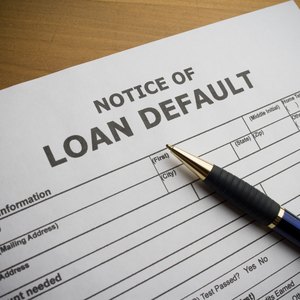
If you're investing in bonds or making someone a loan, you might be concerned with default risk and credit spread risk. Default risk is the danger that a company that's issued a bond or taken out a loan won't pay it back according to its terms, costing you money. Spread risk refers to the danger that the interest rate on a loan or bond turns out to be too low relative to an investment with a lower default risk for it to be a good use of funds.
Tips
Both default risk and spread risk are tools used to measure the potential validity of an investment with respect to the possibility that it will result in a loss of principal. Whereas default risk evaluates the likelihood that an individual or organization will not be able to pay back the principal, a spread risk is used to measure the likelihood that the value of an investment instrument will be negatively impacted by the counterparty in question.
Understanding Default Risk
If you invest in bonds, make individual loans or otherwise get involved in the credit markets, you're generally doing so in the expectation that you'll get paid back over time according to certain spelled-out terms. If a company borrows money and doesn't pay back the principal and interest as it's promised to, it's said to be in default.
Credit ratings help to measure a company or individual's risk of default, but there's still always a risk that some unforeseen event can force someone to stop paying a loan or bond as promised. Not every default means that investors or lenders will never be paid back, since people and organizations can recover from temporary financial problems, but defaults are almost always unpleasant for anyone relying on steady income from an investment.
Companies more likely to default on loans generally must pay higher interest rates, which if they do continue to make payments, can be rewarding for investors willing to stomach the default risk.
Evaluating Spread Risk
One way to evaluate the interest rate on a bond or loan is to compute what's called a credit spread. That's the difference in interest rates between two loans or bonds that mature at the same time. Often credit spreads are computed between corporate or municipal bonds and U.S. Treasury bonds, considered to be among the safest securities to invest in. Computing spreads against Treasury bonds rather than looking at raw interest rate numbers is useful as a way to evaluate potential investments, regardless of whether interest rates in general are historically high or low.
Riskier loans pay higher interest rates and thus carry higher spreads. When people are more concerned about defaults in general, such as when the economy is entering a recession, credit spreads tend to be higher since people are less willing to take on riskier investments, and organizations looking to borrow money have to pay relatively higher interest rates to get investors to take that risk.
Spread risk refers to the risk that the credit spread for a particular investment turns out not to be high enough to justify investing in that particular loan or bond versus other, lower default risk investments, causing the investment to be less worthwhile. For example, if an investor buys a corporate bond with a 3 percentage point credit spread above the comparable Treasury bond, and that premium later drops to 1 percentage point, the value of the bond will drop since investors will be less inclined to take on the added default risk for that smaller spread.
References
- Investopedia: In What Types of Financial Situations Would Credit Spread Risk Be Applied Instead of Default Risk?
- The Motley Fool: What is a Bond Default?
- The Street: What Is a Credit Spread?
- Cambridge Associates: Corporate Pension Plans Should More Actively Consider Credit Spreads When Managing Pension Liability and Balance Sheet Risk, Especially in This Low-Rate Environment
Resources
Writer Bio
Steven Melendez is an independent journalist with a background in technology and business. He has written for a variety of business publications including Fast Company, the Wall Street Journal, Innovation Leader and Ad Age. He was awarded the Knight Foundation scholarship to Northwestern University's Medill School of Journalism.
